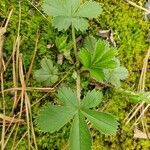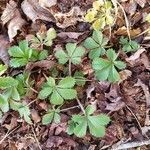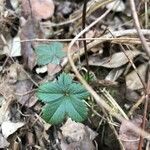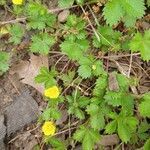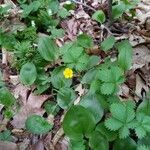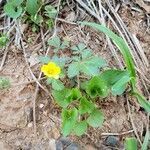Rootstocks erect, stout, 0.5–2 cm. Stems initially ascending to erect, soon becoming prostrate, flagelliform, not branched, eventually rooting at some nodes, (0.3–)0.5–12 dm. Basal leaves ± persistent, usually palmate, 2–9(–11) cm; petiole 1–7(–8) cm, long hairs abundant to dense, appressed to spreading, 1.5–3 mm, mostly ± weak, glands absent or sparse; leaflets (3–)5(–7), central mostly ± obovate to cuneate, sometimes narrowly so, (0.5–)1–4(–6) × (0.5–)0.8–2(–3) cm, distal 1/2 of margin incised 1/4–1/3 to midvein, teeth 2–7 per side, surfaces similar to ± dissimilar, abaxial green to silvery white, sparsely to densely hairy, adaxial green, sparsely to moderately hairy. Cauline leaves 0–1 proximal to 1st flowering node, not fully expanded at anthesis, usually palmate, 2–7(–9) cm; petiole (0.5–)1–6(–7.5) cm; leaflets (3–)5, ± resembling those of basal leaves, apex rounded to obtuse. Inflorescences solitary flowers at stolon nodes. Pedicels (1–)2–5(–9) cm. Flowers 5-merous; epicalyx bractlets linear to lanceolate-elliptic, (2–)3–5(–6) × 0.8–1.5 mm, slightly smaller than to ± equal to sepals; hypanthium 2.5–5 mm diam.; sepals (2–)3–5(–6) mm, apex acute; petals 4–6(–8) × 3.5–6.5(–8) mm, apex rounded to slightly retuse; stamens ca. 20, filaments 0.5–2 mm, anthers 0.4–1 mm; carpels 20–40, styles 0.8–1.4 mm. Achenes 1.2–1.4 mm, smooth. 2n = 28.
More
Much like no. 1 [Potentilla simplex Michx.], but lower and mostly even more slender, the rhizome very short, praemorse, the stems at first anthesis only 5–15 cm, erect or ascending, soon greatly elongating and prostrate, often rooting at the nodes; lowest fl usually in the axil of the first well developed cauline lf, sometimes even from the axil of a scarcely developed lower cauline lf. Dry woods and fields; P.E.I., N.S., and N.B., s. in the coastal states to Ga., inland to s. Ont., s. O., and e. Tenn. Apr.– June. (P. pumila) Not sharply set off from no. 1, with which it sometimes grows, but forming a distinctive taxon of more limited distribution. Most of what has passed as P. canadensis is properly P. simplex.
